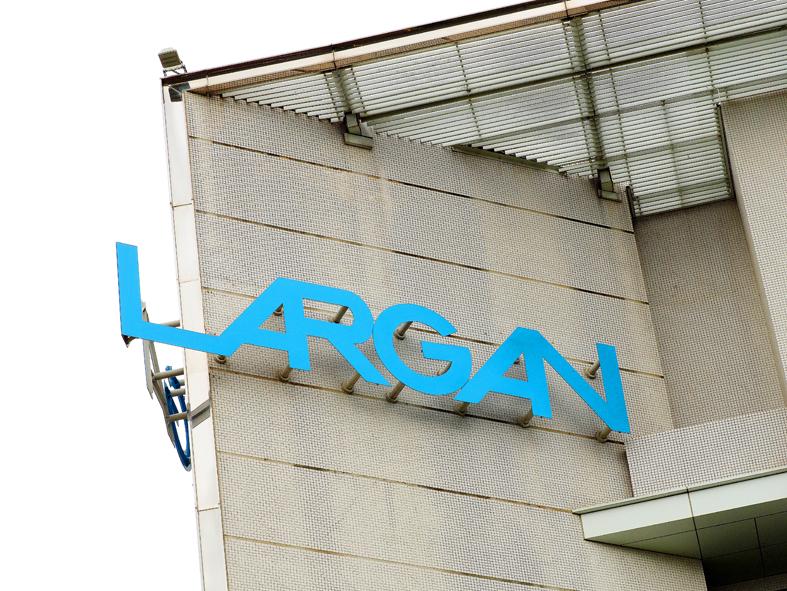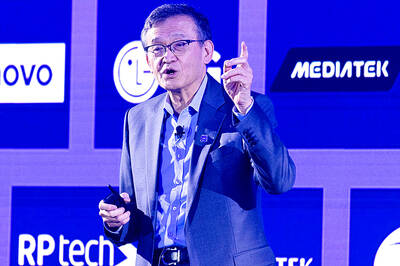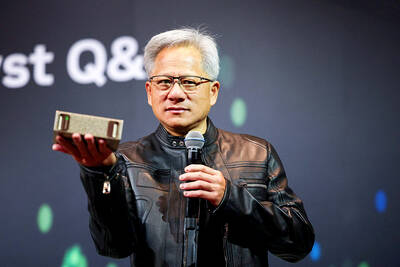Smartphone camera lens maker Largan Precision Co (大立光) yesterday posted its highest net profit since the fourth quarter of 2020, attributing the figure to nonoperating gains, but gross margin continued to slide, falling to the lowest in eight years.
The Taichung-based firm made a net profit of NT$5.51 billion (US$190 million) in the first quarter of this year, up 7.34 percent from a quarter earlier. On a year-on-year basis, profit was up 3.71 percent.
Nonoperating gains contributed NT$2.75 billion, including foreign exchange gains of NT$2.38 billion, Largan said.

Photo: David Chang, EPA-EFE
Earnings per share were NT$41.3, compared with NT$38.37 in the previous quarter, marking the highest in the past five quarters.
However, gross margin fell to 53.36 percent from 55.85 percent in the fourth quarter of last year, compared with 64.77 percent a year earlier.
Last quarter’s gross margin was the lowest since the fourth quarter of 2014, when it was 50.61 percent, company data showed.
Revenue declined to NT$10.13 billion in the first quarter due to a seasonal slowdown, down 22 percent quarterly and 14 percent annually, the company said.
Largan chief executive officer Adam Lin (林恩平) told an online conference that seasonal factors continued to weigh on the company’s business, and revenue for this month and next month would not be higher than last month’s.
Affected by lockdowns in cities in China posting surging COVID-19 case numbers and tight supply for some components, bottlenecks persist in the company’s supply chain, Lin said.
This quarter, Largan’s capacity utilization and product mix would be similar to last quarter, he said, adding that shipments are expected to peak in the second half of the year.
The company — whose customers include Apple Inc, Sony Corp, Samsung Electronics Inc and Huawei Technologies Co (華為) — would continue to focus on high-end lenses for premium smartphones this year, instead of mid-range and low-end lenses increasingly favored by many handset vendors, he said.
Despite slowing specification upgrades in smartphones in the past few months, Lin said that the number of models featuring 8P lens modules is increasing.
An 8P lens contains eight thin layers and is more advanced than lenses with fewer layers.
However, demand for 8P lenses would mainly depend on clients’ production schedules and market conditions, he said.
As for other products, Lin said the company plans to start shipping some lenses for virtual reality devices by the end of this year at an initially small volume, while it would continue to expand its business of automotive lenses.
Largan is constructing new manufacturing facilities in Taichung, with one new plant to be launched in the second quarter of next year, Lin said.
The new plant would start to make revenue contribution as early as in the second half of that year, he said.

Intel Corp yesterday reinforced its determination to strengthen its partnerships with Taiwan’s ecosystem partners including original-electronic-manufacturing (OEM) companies such as Hon Hai Precision Industry Co (鴻海精密) and chipmaker United Microelectronics Corp (UMC, 聯電). “Tonight marks a new beginning. We renew our new partnership with Taiwan ecosystem,” Intel new chief executive officer Tan Lip-bu (陳立武) said at a dinner with representatives from the company’s local partners, celebrating the 40th anniversary of the US chip giant’s presence in Taiwan. Tan took the reins at Intel six weeks ago aiming to reform the chipmaker and revive its past glory. This is the first time Tan

Qualcomm Inc is strengthening its partnerships with Taiwan Semiconductor Manufacturing Co (TSMC, 台積電) and original design manufacturers (ODMs) in Taiwan as it expands its presence in the artificial intelligence (AI) computer market, CEO Cristiano Amon said in Taipei yesterday ahead of the annual Computex trade show. “Historically we’ve always been a very big customer of TSMC, and we continue to be,” Amon said during a media Q&A session. “For chip manufacturing, we’re among the largest fabless [semiconductor designers],” he said, noting that Qualcomm, a leading provider of mobile and AI-enabled chipsets, ships about 40 billion components every year, with TSMC being

‘FAILED EXPORT CONTROLS’: Jensen Huang said that Washington should maximize the speed of AI diffusion, because not doing so would give competitors an advantage Nvidia Corp cofounder and chief executive officer Jensen Huang (黃仁勳) yesterday criticized the US government’s restrictions on exports of artificial intelligence (AI) chips to China, saying that the policy was a failure and would only spur China to accelerate AI development. The export controls gave China the spirit, motivation and government support to accelerate AI development, Huang told reporters at the Computex trade show in Taipei. The competition in China is already intense, given its strong software capabilities, extensive technology ecosystems and work efficiency, he said. “All in all, the export controls were a failure. The facts would suggest it,” he said. “The US

NEW PRODUCTS: MediaTek has been diversifying its product lines to minimize operational risks as mobile chips remain the company’s biggest revenue source MediaTek Inc (聯發科), the world’s biggest supplier of smartphone chips, yesterday said the tape-out process for its first 2-nanometer chip would take place in September, paving the way for volume production of its most advanced chip, likely to be its next-generation flagship smartphone chip, around the year-end at the earliest. MediaTek has been leveraging advanced process technologies from its foundry partner, Taiwan Semiconductor Manufacturing Co (TSMC, 台積電), to build its flagship mobile phone chips, a segment it once relinquished and then recovered four years ago as it released its Dimensity series. In the semiconductor industry, a tape-out refers to the